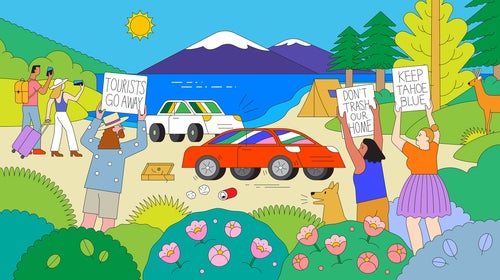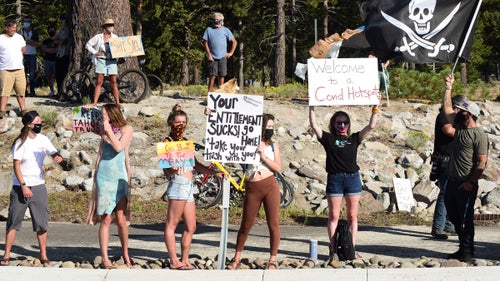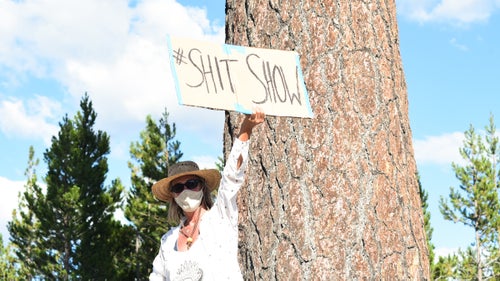When the Techies Took Over Tahoe
Spun-out Teslas on snowy roads. Cabins bought for cash, sight unseen. A shoveling disaster. Locals bemoan the pandemic-induced migration of Bay Area residents to the mountains. But there are two sides to the Zoom-town story.
New perk: Easily find new routes and hidden gems, upcoming running events, and more near you. Your weekly Local Running Newsletter has everything you need to lace up! .
They just kept coming. The day-trippers, Airbnbers, second-home owners, and unmasked revelers. Unleashed after California’s first statewide COVID-19 lockdown ended in late June of last year, they swarmed Lake Tahoe in numbers never before seen, even for a tourist region accustomed to the masses. “It was a full-blown takeover,” says Josh Lease, a tree specialist and longtime Tahoe local.
July Fourth fireworks were canceled, but that stopped no one. August was a continuation of what Lease called a “shit show.”
The standstill traffic was one thing; the locals were used to that. But the trash—strewn across the sand, floating along the shore, piled around dumpsters—was too much. Capri Sun straws, plastic water-bottle caps, busted flip-flops, empty beer cans. One day in early August, Lease picked up a dirty diaper on a south shore beach and dangled it before a crowd. “This anyone’s?” he asked.
Lease was pissed. He couldn’t believe the lack of respect people had for this beautiful area, his home for two decades. Plus, they’d invaded during a pandemic, with them.
That day, after the diaper incident, Lease went back to his long-term rental in Meyers, California, a few miles south of the lake at the juncture of Highways 89 and 50, where he could see the endless stream of cars. An otherwise even-keeled guy, he logged on to Facebook and vented. “Let’s rally,” he posted on his page, adding that he wanted to put together a “non welcoming committee.” He was joking—sort of. But word spread like the wildfires that would soon rage uncontrollably around the state. Before long someone had designed a flyer of a kid wearing a gas mask, with a speech bubble that read “Stay Out of Tahoe.”��It went viral.
On Friday, August 14, at four o’clock, over 100 locals from around the lake began to gather. They commandeered the roundabouts leading into the Tahoe Basin’s major towns—Truckee, Tahoe City, Kings Beach, and Meyers in California, and Incline Village in Nevada—to greet the weekend hordes. Young women in bikini tops, elderly couples in floppy hats, and bearded dads bouncing babies in Björns held up hand-painted signs: “Respect Tahoe Life,” “Your Entitlement Sucks!,” and “Go Back to the Bay.” One old-timer plastered his truck with a banner that read “Go Away” and drove around and around a traffic circle.
But summer turned to fall, which turned to winter, which became spring, and the newcomers are still here. It’s not just the tourists anymore, whose numbers have ebbed and flowed with lockdown restrictions and the weather��and whose trash has gone from wet towels twisted in the sand to . There’s another population of people who came and never left: those freed by COVID from cubicles and work commutes. They migrated, laptops in tow, to mountain towns all over the West, transforming them into modern-day boomtowns: “.”
In Lake Tahoe, the unwelcoming party was hardly a deterrence. The outsiders have settled in.





